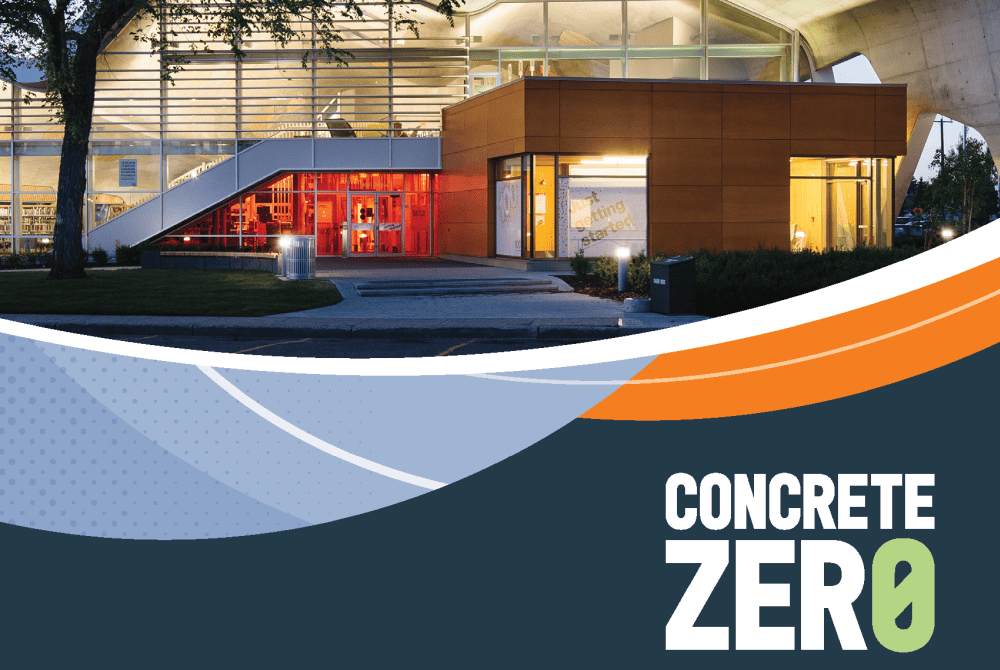
[Image above] Cover of the new Concrete Zero action plan report, which outlines five priority areas that the cement and concrete industry will focus on to reach net-zero emissions. Credit: Cement Association of Canada
As a major contributor to greenhouse gas emissions, the cement and concrete industry is a key focus in many national decarbonization plans. Fortunately, the industry is aware of its carbon footprint, and various regional and global groups within the industry are actively working to help achieve a reduction in emissions.
The Cement Association of Canada (CAC) is one such group focused on reducing emissions. This association, which describes itself as “the voice of Canada’s cement industry,” represents five vertically integrated cement companies across Canada that are committed “to help build thriving, sustainable, and resilient communities for Canadians,” according to CAC’s website.
In the past year, CAC’s advocacy work has gained new prominence with the release of Canada’s 2030 Emissions Reduction Plan in March 2022.
The 2030 Emissions Reduction Plan is the first of several emissions reduction plans that will be issued under the Canadian Net-Zero Emissions Accountability Act. This act, which became law in June 2021, enshrines in legislation the Government of Canada’s commitment to achieve net-zero greenhouse gas emissions by 2050.
The act requires that regular emissions reduction plans be developed to ensure that Canada achieves each of its five-year national emissions reduction targets. This first plan describes the ongoing and planned actions that will help Canada reach its emissions reduction target of 40–45% below 2005 levels by 2030.
Upon the plan’s release, CAC announced that it looked forward to working with the federal government to achieve the plan’s goals. It confirmed this commitment in August 2022 by being the first to join Canada’s Net-Zero Challenge, which encourages businesses to develop and implement plans to transition their facilities and operations to net-zero emissions by 2050.
In November 2022, CAC and the Government of Canada announced the release of the Roadmap to Net-Zero Carbon Concrete by 2050. The roadmap, which CAC helped develop, provides guidance on the technologies, tools, and policies needed for the Canadian cement industry to achieve net‑zero carbon emissions while remaining competitive in a global net-zero economy. It includes the near-term Action Plan to 2030, which addresses immediate efforts and lays out a plan for research and development projects to achieve the 2050 targets.
This month, CAC released yet another document to support the success of these emission reduction plans. The Concrete Zero action plan, announced May 2, outlines five priority areas the cement and concrete industry will focus on to reach net zero. These areas are
- Eliminating the use of coal and petroleum coke as fuel sources for clinker production, while increasing the use of lower-carbon and alternative fuels—including engineered biomass and green hydrogen—which will help drive down emissions. By 2050, 100% of fuel mix will come from non-fossil-based sources.
- Reducing the volume of clinker used to produce cement—which will achieve a 1.5 Mt CO2 emissions reduction over the course of the decade. After 2030, the use of innovative materials, natural pozzolans, and beneficiated waste and recovered materials will increase. In 2050, 4.8 Mt CO2 in emissions reductions will be realized from the reduction of clinker in cement, and cement in concrete compared to a business-as-usual scenario.
- Increasing the use of supplementary cementitious materials in the form of fly ash and ground granulated blast-furnace slag will also play an important role, as will introducing ground limestone, recycled concrete fines, calcined clays, and other new promising materials.
- Working toward building carbon capture, utilization, and storage capacity. Part of that effort will be to build—by 2030—North America’s first commercial deployment of a full-scale carbon capture and storage project at a cement plant.
- Advocating for performance-based codes, standards and specifications, procurement policies, and increased material efficiency in construction.
“Canada’s cement and concrete industry are committed to doing our part to help Canada build a better, cleaner future,” says Adam Auer, president and CEO of CAC, in the Concrete Zero announcement. But “Our Net-Zero Action Plan is ambitious and cannot be achieved by industry action alone. Working with government, industry, and partners in the design, architecture, and construction industry will be essential for success.”
To learn more about how CAC plans to help the cement and concrete industry reach net-zero emissions, view the presentation below that Auer gave as part of a Pacific NorthWest Economic Region webinar in collaboration with the Pacific Northwest Building Resilience Coalition.
